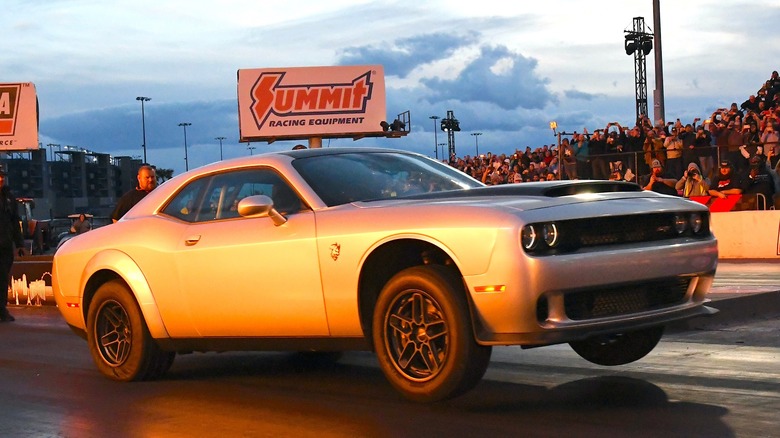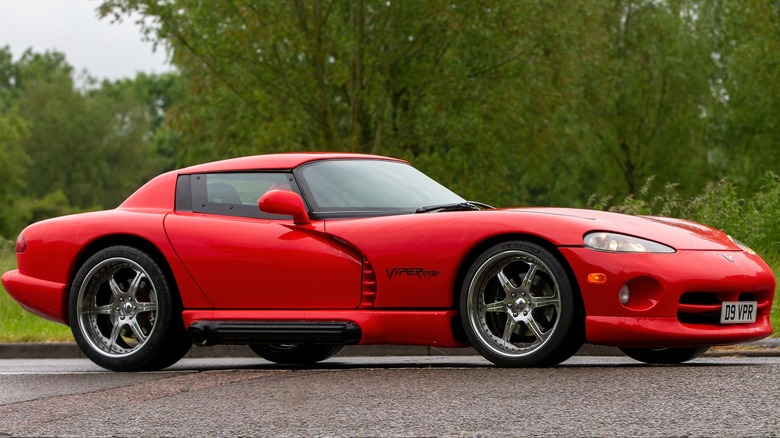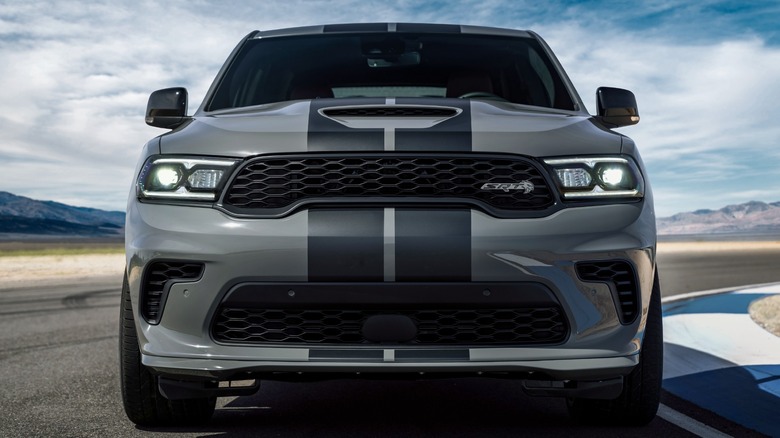What Does SRT Stand For On Dodges?
Automakers develop vehicles covering a wide variety of genres that cater to working professionals, families, and enthusiasts. Engineers are tasked with designing new models and updating existing ones, with compelling looks, features, and technology. Arguably the most exciting department of an auto manufacturer is their performance division, where engineers can break outside the typical constraints of sensible and conservative car design.
Performance divisions are common throughout the automotive industry. A few examples include Toyota's TRD (Toyota Racing Division) department, BMW's M-Series (Motorsports), and Ford's ST (Sports Technologies) models. One of the most notable performance divisions is Dodge SRT, which stands for Street and Racing Technology.
With a tagline "SRT: No Nonsense, All Muscle" you get an idea of what type of vehicle might display this moniker. The point of the Challenger SRT, Charger SRT, and Durango SRT is pure power — perhaps impractical, but loads of fun. Unfortunately, Dodge discontinued the Charger and Challenger in 2023, and the 2024 Durango SRT 392 AlcHemi Last Call Edition will be the final entry for the SUV.
Team Viper and the first SRT cars
What would later become part of the SRT division of Dodge, gained notoriety in the late '80s when they crafted the legendary Viper sports car. Chrysler president of operations Bob Lutz wanted a Dodge equivalent of the Shelby Cobra, but the development of a brand-new prototype was a bold move that involved several risks.
Even more concerning was the small budget of $80 million dedicated for the venture, which even at the time, was considered extremely low for a project of this scope. Fortunately, with the lead engineering prowess of Roy Sjoberg and a group of 85 members encompassing several areas of automotive expertise, Team Viper was born.
More than a decade later in 2003, an unlikely performance candidate, the Dodge Neon SRT-4 was launched. The Neon SRT-4 features a turbocharged 2.4L engine that reportedly could achieve even more than its officially listed 215 horsepower and 245 lb-ft of torque.
Classic muscle returns with a vengeance
A few years following the release of the Viper SRT-10 and Neon SRT-4, some fan favorites from the heyday of the muscle car era made a return. The 2006 Dodge Charger SRT8 rolled off the factory floor with a large 6.1L V8 capable of 425 horsepower.
Then just two years later, the Challenger made a return with the same engine and SRT8 badging. According to GoodcarBadcar.net, the Challenger saw its peak sales in 2018 with 66,716 units sold. Little did automotive enthusiasts realize just how far SRT would push the boundaries of performance in subsequent years.
The automakers performance division ended up creating the most powerful muscle car ever with the 2023 Dodge Challenger SRT Demon 170. With a supercharged 6.2L V8, the SRT Demon 170 unleashes up to 1,025 horsepower from under the hood. The unbelievable output of this car translates to a 0-60 mph time of less than 2 seconds.
This wasn't the only standout SRT in recent years; you won't believe how fast the Dodge Challenger SRT Hellcat really is. The performance team also developed the Jeep Grand Cherokee Trackhawk and the 2021 Ram 1500 TRX, along with many other powerful models. Among the SRT-developed SUV models, the Dodge Durango SRT Hellcat versus the Jeep Grand Cherokee Trackhawk is an interesting matchup with a surprising result.


